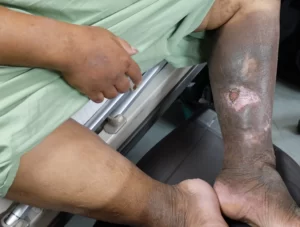Thoracic Outlet Syndrome (TOS) is a complex medical condition that affects the upper body, particularly the thoracic outlet syndrome symptoms the area between the neck and the shoulder. It occurs when there is compression or irritation of the nerves, blood vessels, or both, in the thoracic outlet region. Thoracic Outlet Syndrome can cause significant discomfort and limitations in daily activities. In this blog post, we will explore the causes, symptoms, and treatment options for Thoracic Outlet Syndrome.
What is Thoracic Outlet Syndrome?
Thoracic Outlet Syndrome (TOS) is a medical condition that involves the compression or irritation of nerves, veins, arteries, or both, in the thoracic outlet region. The thoracic outlet is a narrow space located between the collarbone (clavicle) and the first rib, and it serves as a passage for several structures, including nerves, arteries, and veins that supply the upper extremities.
When the structures in the thoracic outlet become compressed or irritated, they can cause an aching pain and range of symptoms in the neck, shoulder, arm, and hand. TOS can be categorised into different types based on the structures involved.

What are the types of thoracic outlet syndrome?
1. Neurogenic Thoracic Outlet Syndrome:
This is the most common form of Thoracic Outlet Syndrome. Neurogenic Thoracic Outlet Syndrome occurs when there is compression of the brachial plexus, a network of nerves that controls movement and sensation in the upper extremities.
2. Vascular Thoracic Outlet Syndrome:
In this type, the compression affects the blood vessels in upper chest, primarily the subclavian artery or vein. Venous or arterial TOS (Thoracic Outlet Syndrome) is relatively rare but can cause serious complications if left untreated such as blood clots.
3. Non Specific Thoracic Outlet Syndrome:
This category includes cases where the symptoms do not fit precisely into neurogenic or vascular Thoracic Outlet Syndrome. It may involve a combination of nerve and vascular compression or may not have a clear anatomical cause.
What causes thoracic outlet syndrome?
The ” prevent thoracic outlet syndrome, is a small space between the collarbone (clavicle) and the first rib. Several structures pass through this narrow space, including nerves, arteries, and veins. Sometimes congenital abnormalities in pregnancy may cause chest or neck pain, but it can happen after injury or body building. Cervical rib : A cervical rib is a rib extension which grows from the spinal nerve in the neck. Between 1 and 3 percent of the population has the cervical rib that can reach to either side and attach to the first rib. The cervical rib increases the chances that blood or nerve pressure can become compressed by the rib muscle and ligament. In some individuals, the cervical rib is affected by the thoracic outlet syndrome.

– Poor posture:
Slouching or maintaining an improper posture can put undue pressure on the thoracic outlet, leading to nerve or vascular compression.
– Trauma:
Injuries such as whiplash or fractures in the collarbone or ribs can result in Thoracic Outlet Syndrome.
– Repetitive movements:
Certain occupations or activities that involve repetitive motions of the upper extremities can contribute to the development of Thoracic Outlet Syndrome.
– Anatomical variations:
Some individuals may have an extra cervical rib or an abnormal first rib, which can increase the other risk factors of Thoracic Outlet Syndrome.
– Muscle tightness:
Tightness or spasms in the shoulder muscles or around the neck and shoulder can compress the structures in the thoracic outlet.
How is thoracic outlet syndrome diagnosed?
Diagnosing Thoracic Outlet Syndrome (TOS) typically involves a comprehensive evaluation that includes a thorough medical history, physical examination, and diagnostic tests. The process may involve multiple healthcare professionals, such as primary care physicians, orthopaedic specialists, neurologists, or vascular surgeons. Here are the key steps involved in diagnosing Thoracic Outlet Syndrome:
1. Medical history:
The healthcare provider will begin by discussing your symptoms, their duration, and any factors that worsen or alleviate them. They will inquire about any previous injuries, surgeries, or medical conditions that may be relevant to your symptoms. Providing a detailed and accurate medical history is crucial for guiding the diagnostic process.
2. Physical examination:
The healthcare provider will perform a physical examination to assess your posture, range of motion, muscle strength, and sensation in the affected areas. They may check for any visible signs of swelling, discoloration, or muscle wasting. The examination may include specific manoeuvres, such as the elevated arm stress test, designed to reproduce or exacerbate Thoracic Outlet Syndrome symptoms.
3. Nerve conduction studies (NCS) and electromyography (EMG):
These tests are often performed to evaluate the function of the nerves and muscles in the affected arm. NCS measures the speed and strength of nerve signals, while EMG assesses the electrical activity in muscles. Abnormal results can indicate nerve compression or damage associated with Thoracic Outlet Syndrome.
4. Imaging studies:
Various imaging tests may be ordered to visualise the structures in the thoracic outlet and identify any abnormalities. These may include:
– X-rays:
X-rays can help assess the bones, joints, and alignment of the thoracic outlet. They may reveal the presence of an extra rib or bony abnormalities that contribute to Thoracic Outlet Syndrome.
– Magnetic Resonance Imaging (MRI):
An MRI scan provides detailed images of soft tissues, including nerves, arteries, veins, and muscles. It can help identify any structural abnormalities, such as disc herniations or tumours, that may be causing TOS.
– Computed Tomography (CT) scan:
CT scans can provide detailed images of the bones and blood vessels, allowing for a thorough evaluation of the often developing thoracic outlet syndrome.
– Doppler ultrasound:
This test uses sound waves to evaluate blood flow through the arteries and veins. It can help identify any vascular compression or obstruction in cases of vascular Thoracic Outlet Syndrome.
5. Provocative tests:
Provocative tests are performed to reproduce or aggravate TOS symptoms and assess their response. Examples include Adson’s manoeuver, Wright’s test, Roos test, and Allen’s manoeuver. These tests involve specific movements or positions of the arms and head to provoke symptoms and determine if there is nerve or vascular compression.
What are the signs/symptoms of Thoracic Outlet Syndrome?
Thoracic Outlet Syndrome (TOS) is a condition that occurs when there is compression or irritation of the nerves, blood vessels, or both in the thoracic outlet. The thoracic outlet is the space between the collarbone (clavicle) and the first rib. The signs and symptoms of TOS can vary depending on which structures are affected. Here are some common signs and symptoms associated with Thoracic Outlet Syndrome:

1. Shoulder, Neck, and Arm Pain:
Pain is one of the most prevalent symptoms of TOS. It typically starts in the shoulder and lower neck, region and may radiate down the arm. The pain may be described as aching, sharp, or burning. It may worsen with certain arm movements or activities.
2. Numbness and Tingling:
Individuals with TOS may experience numbness or tingling sensations in the arm, hand, and fingers. This can occur along specific nerve distributions, such as the ulnar nerve (inner side of the forearm and hand) or the median nerve (thumb, index, and middle fingers).
3. Weakness:
Weakness in the arm, hand, or grip strength can be a symptom of TOS. It may be challenging to perform tasks that require fine motor skills, such as holding objects or buttoning clothes.
4. Swelling:
Some individuals with TOS may experience swelling in the affected arm or hand. This swelling may be accompanied by changes in skin color or temperature.
5. Arm Fatigue:
TOS can cause fatigue or heaviness in the arm, particularly with repetitive or prolonged activities. Holding the arm in certain positions, such as above the head or outstretched, may exacerbate the symptoms.
6. Impaired Circulation:
In cases where blood vessels are compressed, symptoms related to impaired blood flow can occur. This may include coldness or discoloration of the hand or fingers, weakened or absent pulses, or the development of blood clots (thrombosis) in the veins.
7. Muscle Atrophy:
In chronic or severe cases of TOS, muscle wasting or atrophy may occur. This is characterized by a noticeable decrease in muscle size and strength in the affected limb or arm.
It’s important to note that the symptoms of TOS can overlap with other conditions, such as carpal tunnel syndrome, cervical radiculopathy, or brachial plexus injuries. Therefore, it’s essential to consult with a healthcare professional, such as a physician or physical therapist, for an accurate diagnosis and appropriate treatment.
How is thoracic outlet syndrome treated?

The treatment of Thoracic Outlet Syndrome (TOS) aims to alleviate symptoms, improve function, and address the underlying cause of the condition. The specific treatment approach may vary depending on the type of TOS (neurogenic, vascular, or nonspecific) and the severity of symptoms. Here are some common treatment options for TOS:
1. Physical therapy:
Physical therapy plays a crucial role in the management of Thoracic Outlet Syndrome. A physical therapist can design an individualised exercise program to improve posture, strengthen muscles, relieve pain, and correct any muscle imbalances. As part of your physical therapy program, They may also use techniques such as manual therapy, stretching, and mobilisation to relieve tightness and improve range of motion.
2. Pain management:
Over-the-counter pain medications, such as nonsteroidal anti-inflammatory drugs (NSAIDs), may provide temporary relief from pain associated with TOS. In more severe cases, a healthcare provider may prescribe stronger pain relievers. However, it is important to use pain medication under medical supervision and follow the recommended dosage guidelines.
3. Lifestyle modifications:
Making certain changes to daily activities and habits can help manage TOS symptoms. This may include avoiding activities that worsen symptoms, practising good posture, taking frequent breaks during repetitive tasks, and using ergonomic adjustments in work or home environments to relieve symptoms.
4. Ergonomic modifications:
Adjusting workstations, desks, and chairs to ensure proper ergonomics can help reduce strain on the neck and shoulder region. Employing ergonomic principles, such as maintaining a neutral posture and using supportive equipment, may alleviate TOS symptoms.
5. Nerve gliding exercises:
Specific exercises that involve gently moving the affected nerves can help reduce irritation and improve nerve mobility. These exercises, often guided by a physical therapist, aim to alleviate symptoms caused by nerve compression in neurogenic TOS.
6. Vascular interventions:
In cases of vascular TOS, where there is compression or obstruction of veins or arteries, medical or surgical interventions may be necessary. This can involve medications to prevent blood clots, angioplasty to widen narrowed arteries, or surgical procedures to remove the cause of blood vessel compression, or create more space for the blood vessels.
7. Botox injections:
In some cases of neurogenic TOS, injections of botulinum toxin (Botox) into specific muscles can help reduce muscle spasms and alleviate other symptoms too.
8. Surgery:
Surgery is considered a last resort when conservative treatments fail to provide relief. Surgery aims at throacic outlet decompression.The type of surgical procedure depends on the specific cause of TOS and may involve removing an extra rib, releasing tight muscles or ligaments, or repairing damaged blood vessels or nerves through vascular surgery.
It is important to note that the choice of treatment depends on individual factors, including the type and severity of TOS, overall health, and patient preferences. A comprehensive evaluation by a healthcare professional specialising in TOS is essential to determine the most appropriate treatment plan for each individual case.










